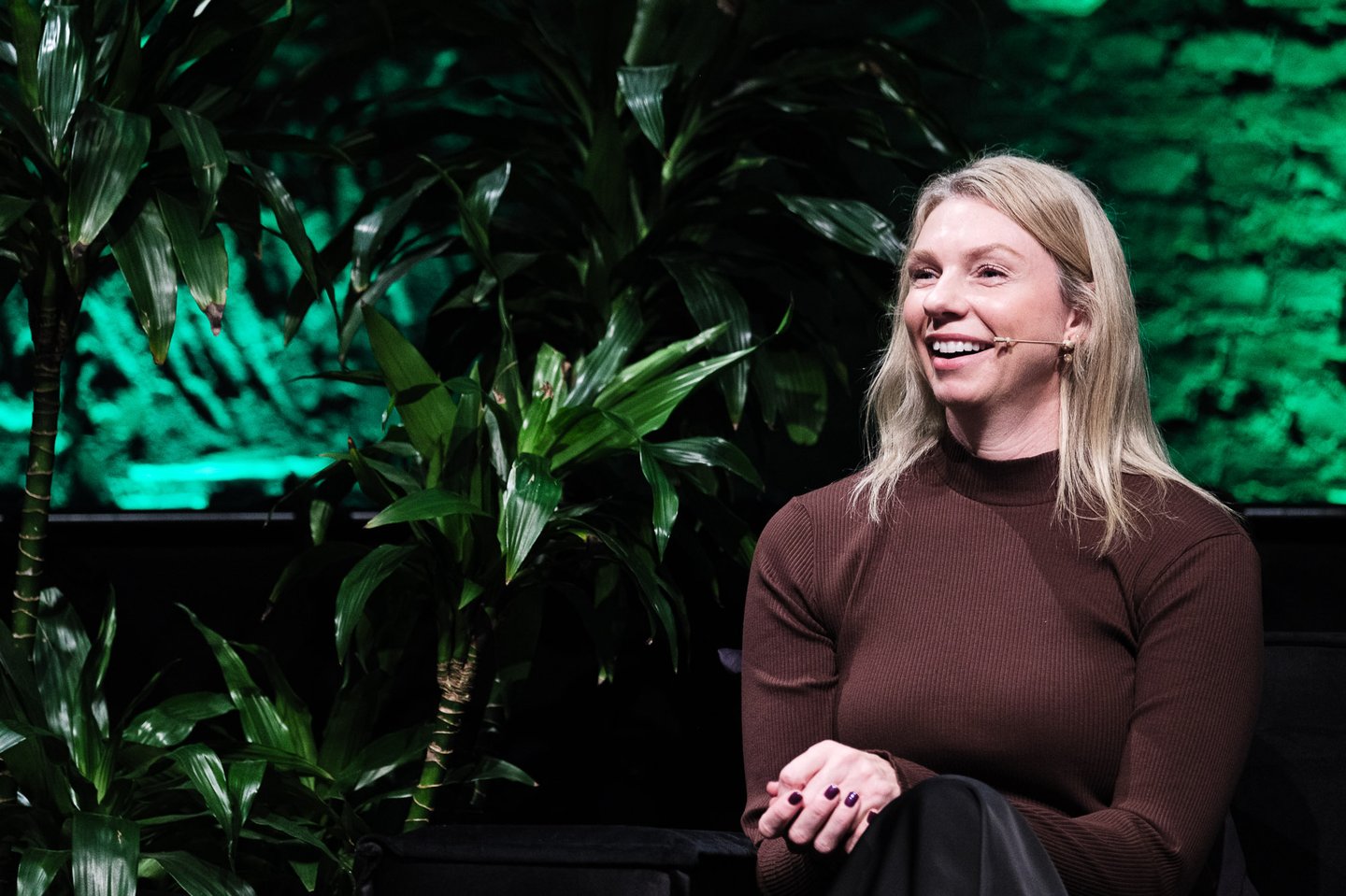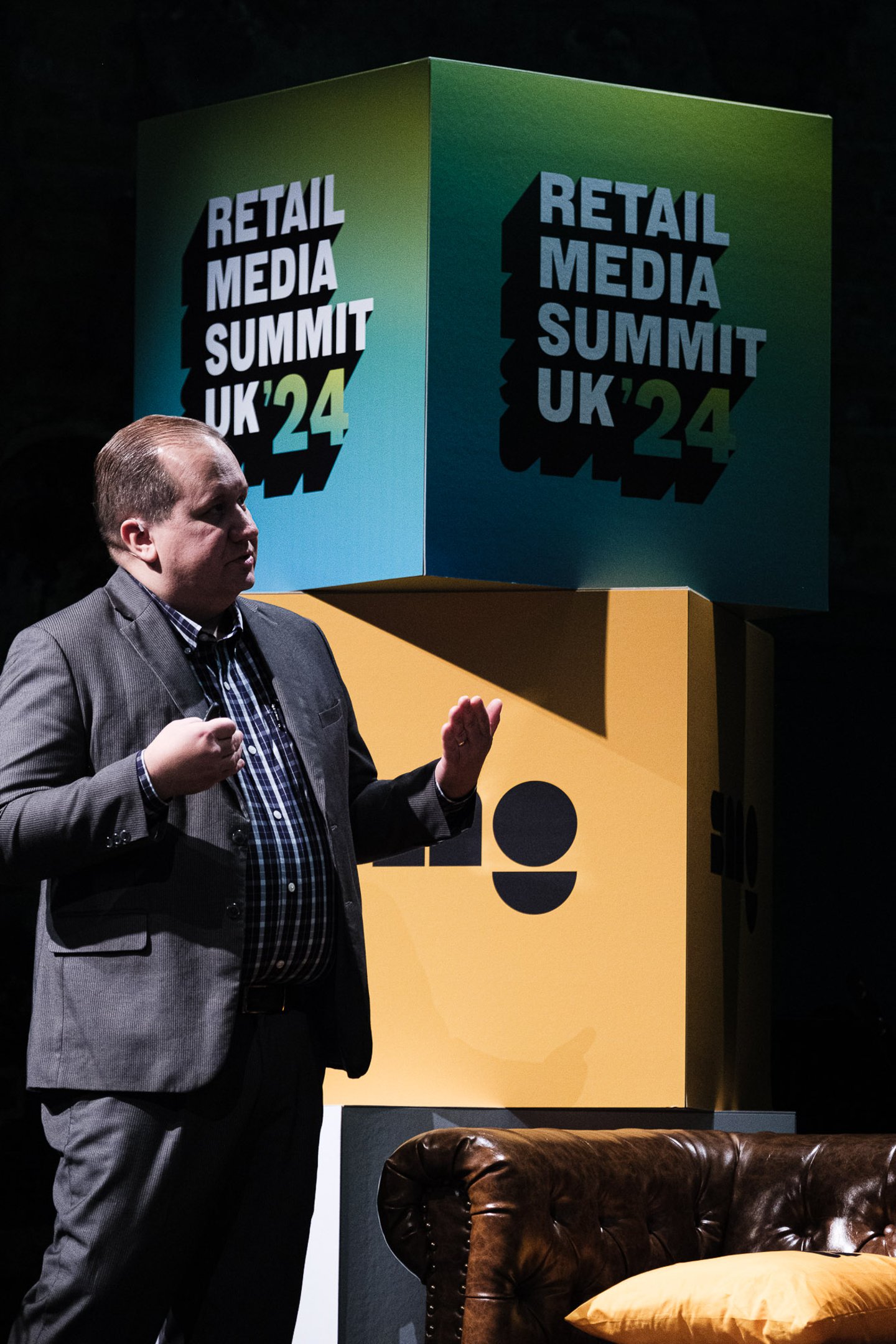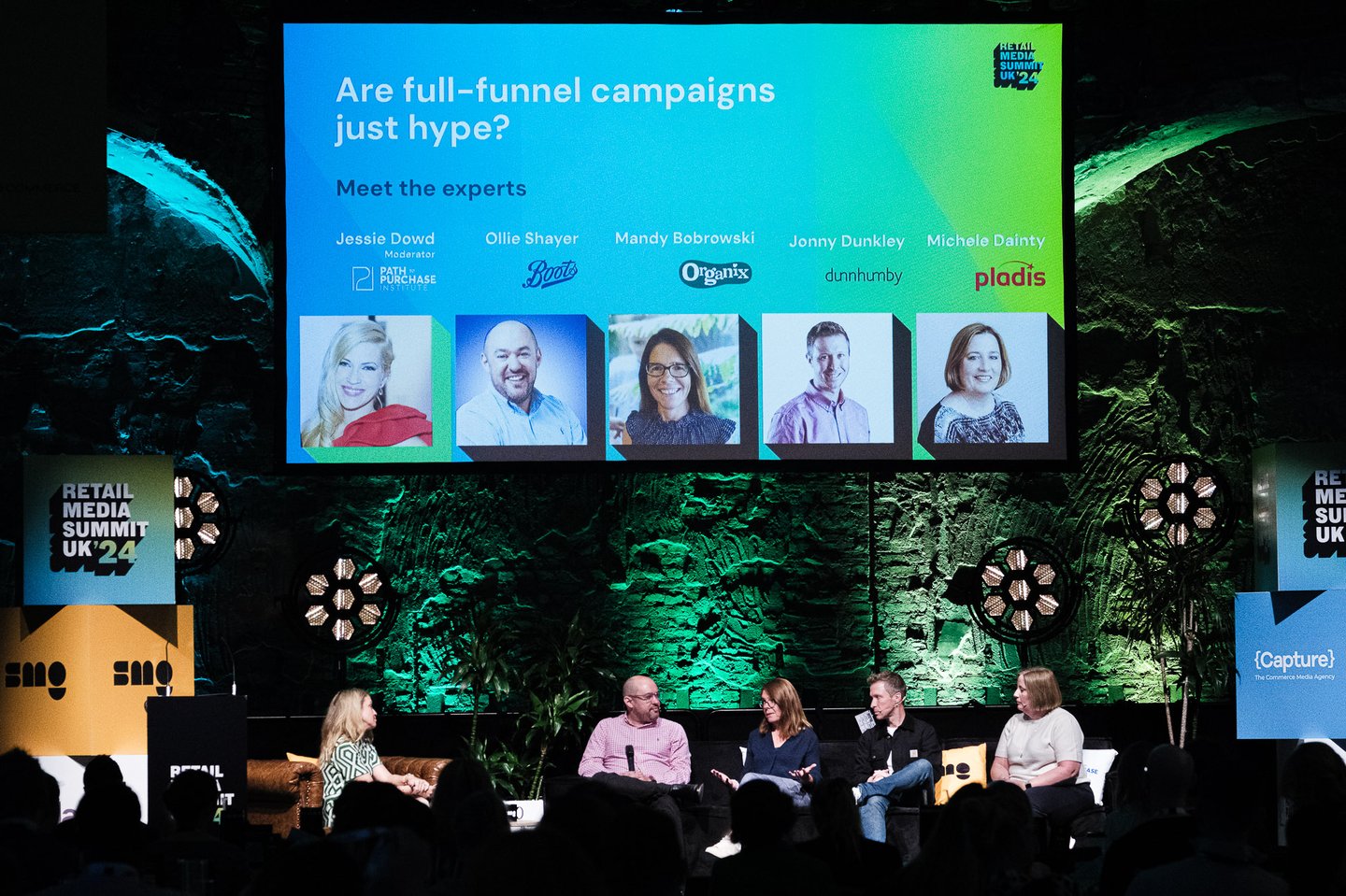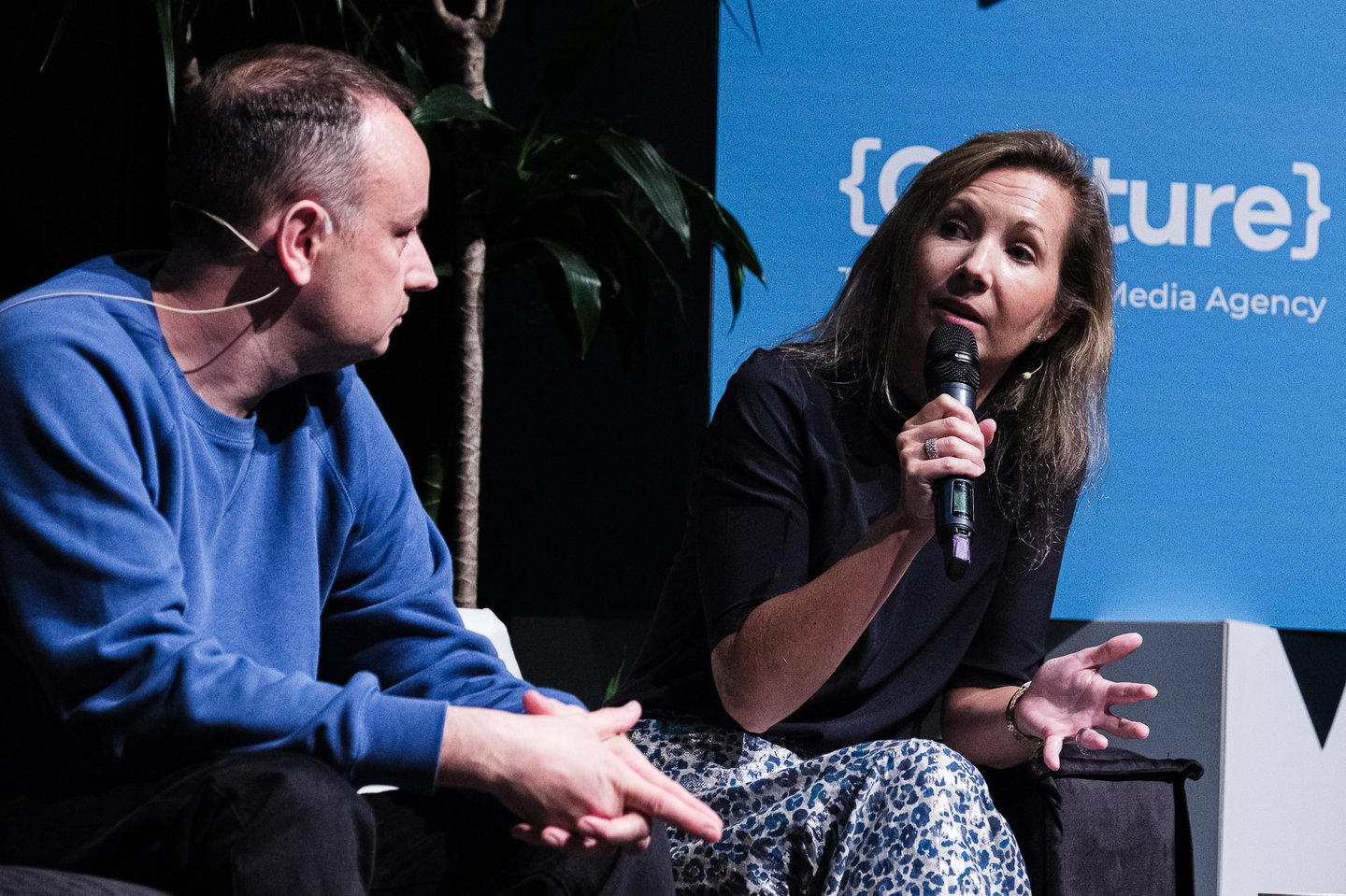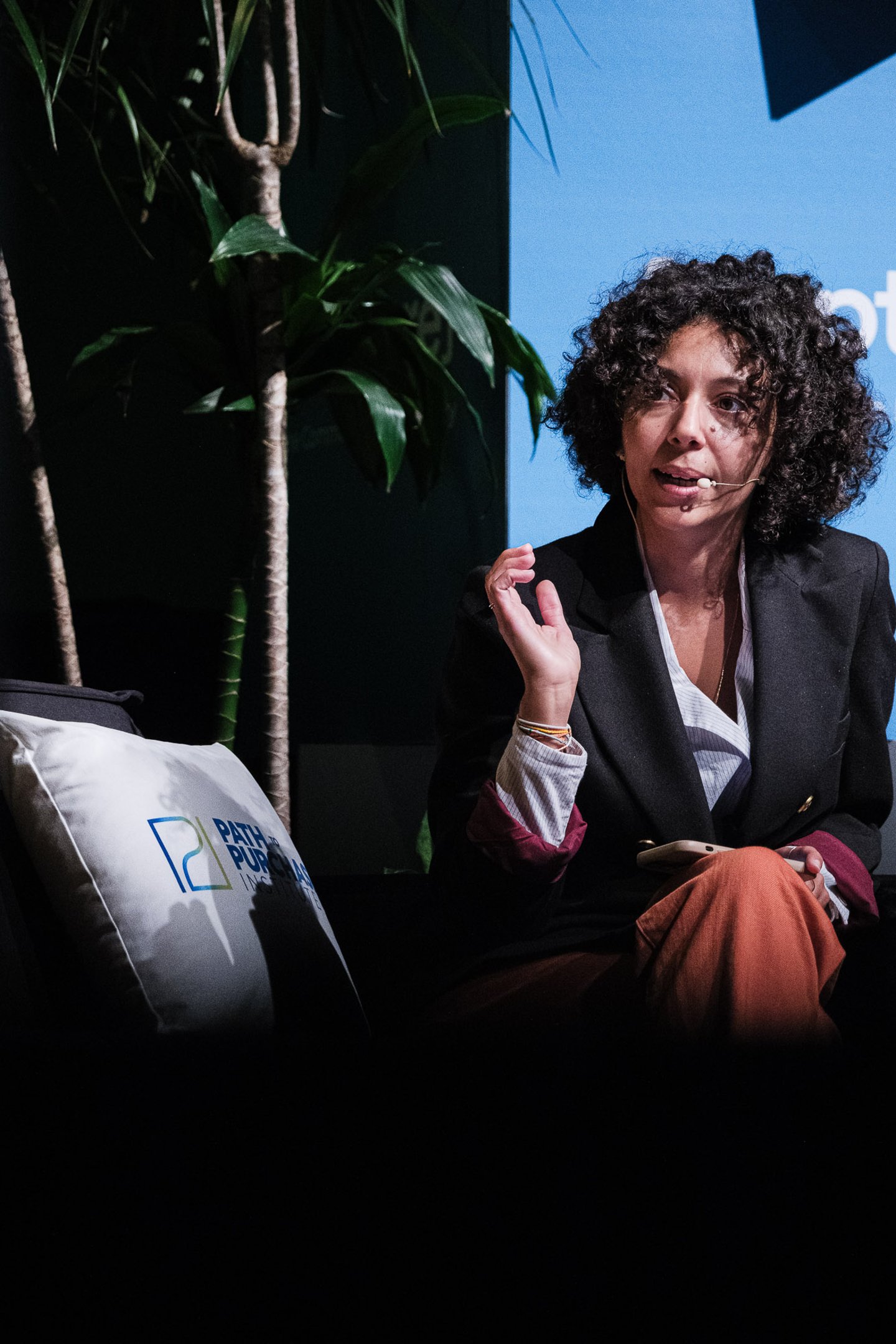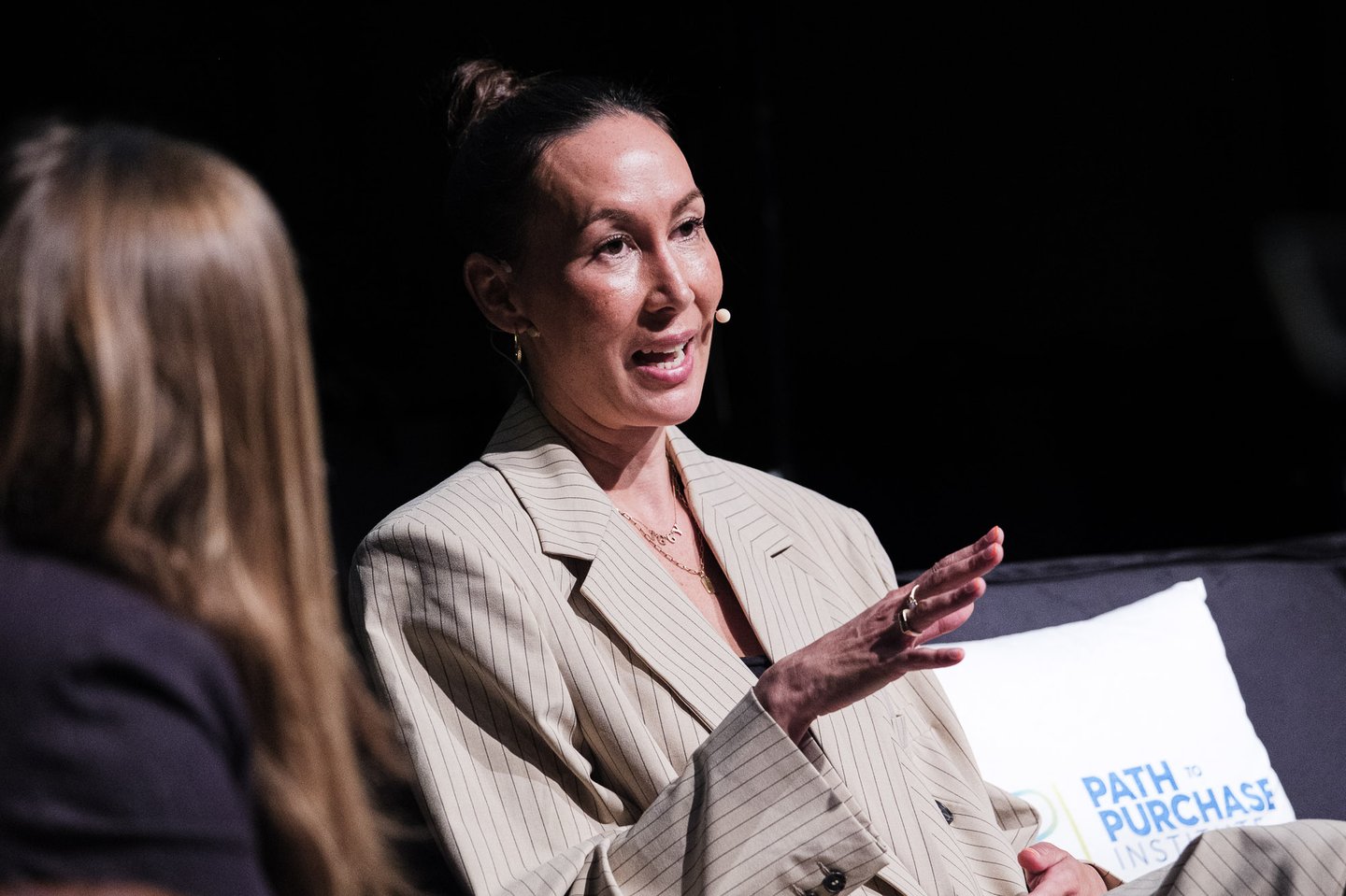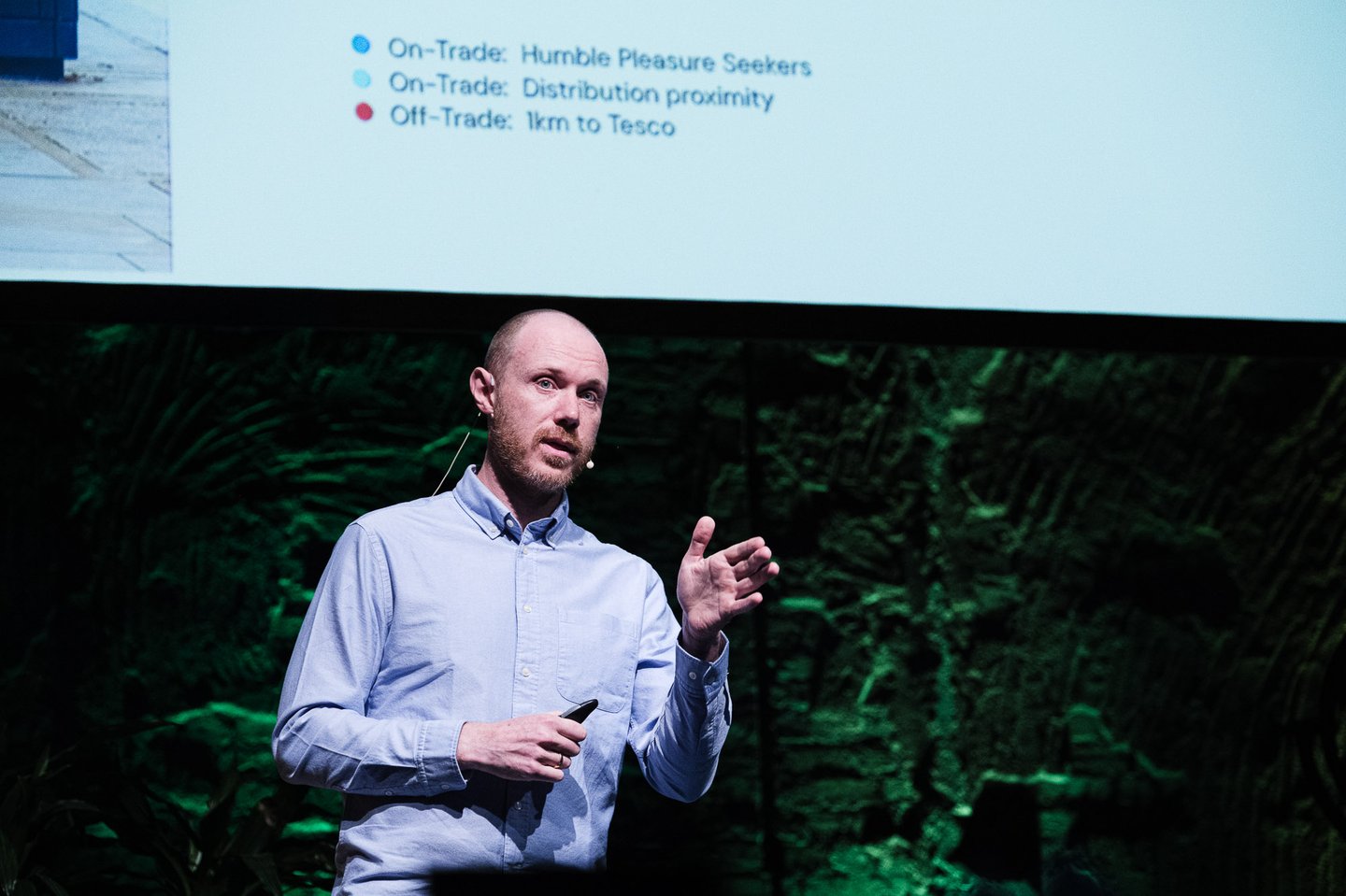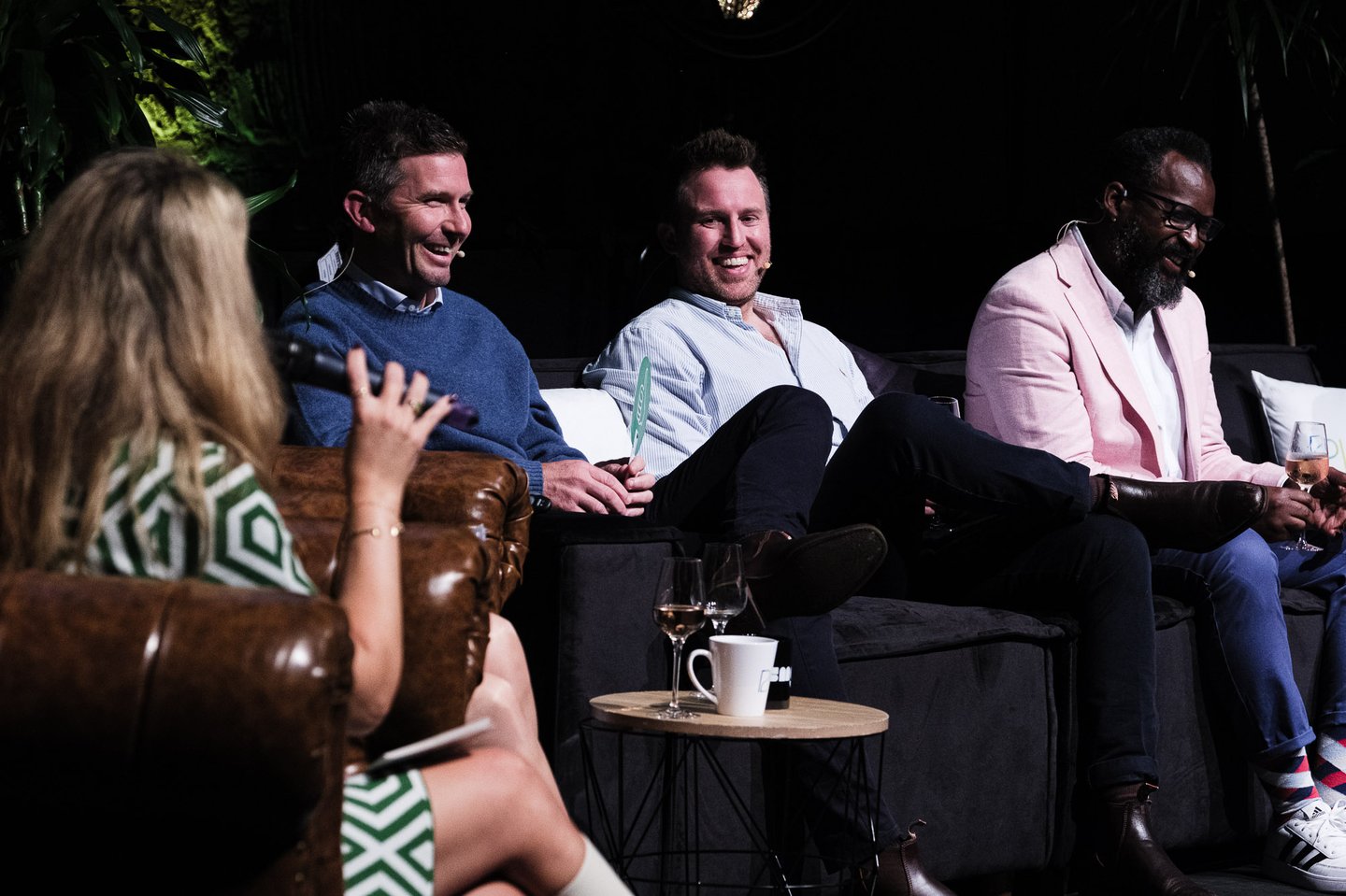Retail Media Summit UK 2024 Recap
The second Retail Media Summit UK took place in Battersea, southwest London, on Oct. 16, as the Path to Purchase Institute and SMG put together a packed agenda to discuss the evolution of retailer media networks in the U.K.
While the industry is still nascent, more U.K. retailers have created retail media networks (RMNs) since the debut event landed in Shoreditch last year — and a growing number of major brands are spending their marketing budgets on in-store and out-of-home advertising.
The sold-out event came to London to provide more about the future of RMNs and to discuss the main opportunities and challenges as the industry emerges as a major channel to reach consumers within the retail ecosystem.
- RMS UK 2024 Takeaways from Kevel
From the power of first-party data to in-store going digital, Paul Astbury, sales director at Kevel, the official sponsor of the RMS UK 2024 recap, shares his key takeaways from the event. Click here to read all his insights.
Can Retail Media Networks Meaningfully Differentiate in an Increasingly Competitive Market?
Opening speaker Jessica Myers joined online department store retailer The Very Group as chief marketing officer with a strong financial services background behind her, including financial services regulatory experience, which she said was key given the huge amount of data Very Group holds on its customers.
“Very Group has 4.5 million customers and is a pure-play department store, with the majority of customers paying in installments,” said Myers, now the retailer's chief customer officer. “We have a lot of data, so the duty of care is immense.”
Myers said that she started by looking at where growth would come from, unlocking the brand, communications with the customer, and now reimagining the company’s retail media network.
“That was through a brand refresh, creating a single brand platform for us and for the brands we work with,” she said. “The scale of data points we have, about 500 for each customer, means that understanding how to use that is really important in gaining shopper insights.”
Myers said that the key things that brands are looking for when advertising on Very Group’s site are measurement, plus customer insights, which means that retailers need to provide tools to demonstrate why they should invest with your business.
“We’re on a growth trajectory,” she said, “scaling and being flexible, bringing creative solutions, because brands are calling out for innovation. You'll see some pretty interesting things from us this Christmas.”
In-Store Media: Digital Out of Home or Next-Generation Shopper Marketing?
The main difference between channels is the funnel placement in terms of contextual journeys, Stratacache CEO Chris Riegel said, pointing to digital out of home (DOOH) as predominantly top of funnel, while in-store is more focused on conversion, with adjacencies vital.
“We need proper curated journeys; does it make sense to see a BMW advert when shopping in the baby area of a store? Also think of value, which is dramatically higher being much closer to the point of conversion,” Riegel said. “Conversion results drive the rate. For example, RMNs represent 3% of Walmart sales, 20% of its margin, which is important in challenging economic times. You need to think of this as an opportunity for brands to spend money in-store rather than on TikTok and other platforms — so it is an incremental income.”
He also stressed the need to ensure consent when interacting with customers, an issue that is particularly important in Europe, which has strict privacy laws.
“Cameras are dead; they are biometrically finished. And they're absolutely suicide from a brand perspective. So you're seeing movement now to more customer identification and tracking that ties back to loyalty programs, where customers opted in,” Riegel added.
Riegel also stressed the importance of measurement standardization and warned of “fluffy misinformation” in terms of some store calculations, lacking in sophistication, and the need for contextualized journeys.
“Behavior is highly trackable on the tech side to see how customers interact at the checkout, when you're tracking loyalty, say when you go into a grocery store, you do that one time, 10 times, 100 times. Humans are incredibly predictable mathematically in buying habits, so you can build that persona, that profile around that journey, and predict when you're coming into the store, what you're most likely interested in, and then use that with either artificial intelligence or predictive algorithms to say what would be most interesting to you,” he said.
In terms of understanding the role of the channels, he added that TV is not a conversion opportunity in the way that the store is, lacking the level of personalization and conversion value available within a store environment.
“From a retailer perspective, your audience is so valuable, you should be pushing the rate up. You push that rate up, you drive more metrics around the success and conversion. That's something that other forms of media cannot do the same way and at the same scale,” he said.
- Are We Sugarcoating the Real Challenges Facing Retail Media?
SMG’s Lee LeFeuvre said the five key issues facing retail media networks are:
- Senior leadership buy-in
- Resource and skill sets
- Unclear retail media network point of differentiation
- Lack of transparency
- Unrealistic expectations
Should Retail Media Stop Trying to Own Everything in the Funnel and Focus on Its Strengths — Conversion?
P2PI and SMG teamed with marketing effectiveness consultancy MESH Experience on a consumer study focused on the upper funnel impact of retail media networks. Findings were unveiled at the event during a session moderated by Cyndi Loza, P2PI’s senior editor.
“We know a ton about how retail media helps brands from a sales-driving perspective. We know a lot about how it impacts bottom of the funnel metrics. We've measured over 15,000 campaigns, and we've done that for over 2,000 different brands, across 300 different media channels. So we've got tons of that data,” said Katie Streeter Hurle, SMG chief strategy officer. “But actually what's really interesting is that that data is now very broad and it's also very deep, and so it's helping us to understand the sales-driving effects of retail media campaigns in a way that is helping brands make better investing choices moving forward.”
She said that data is helping advertisers shift their spend, and look at the most effective ROI, with more brands investing in retail media measurement strategies, improving their ROI over time as well.
“It's quite normal as an advertiser, when you start investing in retail media, to be at break-even point. But if you're investing in retail medium measurement, maybe you're using that data to improve the campaign planning and you're feeding that into every campaign that you run, to start improving your ROI incredibly dramatically,” Streeter Hurle added.
Fiona Blades, MESH Experience president and chief experience officer, said of the research that capturing people's experiences in real time, then asking them to become a researcher and to record whenever they see, hear or experience anything to do with a brand, allowed the company to contrast that brand awareness with consumers who do not have that experience.
“That's how we're able to unpick exactly what causes a change in brand perception, as opposed to what just correlates with it. So what we did for this particular study is we've really focused on the paid retail media experiences and captured people's emotions in the moment, and we can see how positive, persuasive and relevant these experiences are,” Blades said.
She added that this showed a big impact on advocacy, with retail media affecting people's perception of brand awareness and in-store experiences having an even higher impact than overall consumers. “That's around five times the impact that we're seeing from people who do not have retail media experiences,” she said. “From my perspective, this really does turn things on their head. You know, retail media is an untapped powerhouse when it comes to building brands.”
Are Full-Funnel Campaigns Just Hype?
One of the key debates across the day was over how the different channels fitted, how their combined impact could be distilled and measured, and what part of the funnel each channel operated within. Jessie Dowd, Path to Purchase Institute editorial director, asked four experts about whether full funnel was achievable or hype, and here’s what they said.
Jonathan Dunkley, Tesco Retail Media agency group head:
“We're trying to stitch together channels from what's been built for the last 25 years. So there is a lot of focus from a Tesco media perspective on building out our systems and processes to bring together as many channels for insights and planning, buying and measuring. There's a lot of investment going in to kind of democratize the buying and really put it in people's hands. And there's a really big push from our end on measurement as well.”
“We announced that for our measurement program going into next year, we’re going to look at how we can achieve omnichannel attribution. It’s not that easy to do, but something that's going to be critical to us, building that success and demystifying some of this going forward.”
“We've just passed 4,000 digital screens across Tesco in the U.K., and that scale is only growing. We were the first retailer to put ads on our scanners and shop devices, which is massive, 70 million transactions across that in the last year. And we've just started testing location-based ads on that. There's a huge amount of innovation going into the store, and bringing that, what was traditionally cardboard, to life and allowing us to feed data into everything in-store.”
Ollie Shayer, Boots omni-media director: “We're seeing more and more, the way in which you can connect to different parts of the funnel with already tailored data, so across the funnel, from channels that are more traditionally upper funnel, but equally also the kind of objectives that we're seeing brands talk to us about. Not just commercial objectives, but actually objectives that are about driving awareness.”
Mandy Bobrowski, Organix marketing director:
“You start every campaign with some sets of objectives, and sometimes that doesn't need to go all the way through the funnel. Play that matrix of time, costs and quality, and where you want to invest your time and the quality of the messaging that you want to be delivering.”
“We're doing lots of these already full-funnel campaigns — that can be massive executions across in-store and online — and we've seen that actually if you run three channels, you'll find you get more than four times the sales rise over running just one.”
Michele Dainty, Pladis Global, head of shopper marketing, UK & Ireland: “I don't think it's hype. It's really key to make sure that you've got that red thread going all the way through to the point of purchase. You can have a really, really small funnel campaign, or you can go with an all singing, all dancing, everywhere campaign. So it's about that balance and what the overarching objectives are.”
- The ROI Obsession: Will Short-Term Wins Always Steal the Show?
“Not all ROI is built equal, what we should be focused on is incremental ROI and uplift. We break it into three building blocks: Build a bank of strong ROI performers; understand use of channels; and work towards an omnichannel approach to campaigns.” — Bianca Hall, SMG senior insight director
Should Retail Media Networks Act More Like Media Companies and Less Like Retailers?
The idea of stores being a media channel has been around for a long time, but retail media networks are making that longtime objective a genuine option. IAB’s James Chandler asked four retailers what they thought, and here’s what they said.
Stuart Michell, WHSmith North America chief commercial officer:
“WHSmith has been in North America for just over three years. And the very different thing about the North American business [from the U.K.] is if you travel through the airport in North America, you won't see a WHSmith-branded store as you would in Heathrow or London Gatwick. They're very bespoke and localized to the area. So as a travel retailer, as a retail media network, we have something very hard, how we capture the hearts and minds of those travel customers without that underlying [unified] brand, underpinning.”
“We have to be really intentional about how we target our customers when it comes to retail. Retail media is a real opportunity to be as close as we can to the point of purchase in an environment where there is high spend, where there is high engagement as well.”
Susie Moan, Currys chief data officer:
“Customer experience is a really massive focus at Currys, and product remains a big focus. We help everyone enjoy amazing technology, and that is our mission. And then our colleagues are a really important part of our business, as the U.K.'s largest tech retailer, and we are truly omnichannel, so our colleagues play a big part in it.”
“And so on the one hand, we truly see ourselves as a retailer, and Currys connected media is part of that, but equally, that's why we brand that as something different, because it is different. We will always prioritize our relationship with our customers over advertising goals. But we think there are some really acute opportunities that we can scale.”
John Mathieson, Deliveroo global director - media and advertising:
“We obviously have a huge amount of data. We do something like 300 million transactions over the year. So you imagine, as a result of that, we know an awful lot about customers in a whole variety of different situations. So whether that's when they're buying restaurant food, whether that's when they buy groceries, whether, more recently, that's when they start buying other products and services that are now available.”
“So how do you use the space where advertising kind of generates these incremental assets, but make sure it complements the guest experience, not only through giving inspiration on new drinks or products or services, but also creating an endemic as well? Is it the right thing? If I'm a guest, I don't want to be spammed by ads.”
Jessica Cooke, Stonegate Group, head of media and loyalty:
“We have over 3,500 screens. We've done that in less than a year, so I think we've taken a lot of the ad space by surprise with how quickly we scaled. We are in that infancy.”
“So I think we have something really cool, because it has this real point of difference in terms of having really engaged quality audiences, and that makes something really interesting to advertisers, to buy, in a way that I think thinking about these kind of dynamics, it's sometimes looked at like when compared to something on roadside when you're seeing it for two seconds, versus now and having you. But that quality of data is the next thing we really want to build.”
Can Retailers Really Save Brand Marketing?
Jenny Holleran, Kroger Precision Marketing group director of media, opened the afternoon session by underlining the potential of retail media networks, something which the U.S. grocery operator has been at the forefront of, bolstered by its rich first-party loyalty card data.
“One of the unique things about retail media is, as retailers, we care just as much as the brands do about selling product. So there's something really special about retail media, and we should be proud to have retail media networks, and for brands to really want to be a part of those retail media networks,” Holleran said, while stressing that consumers are not as loyal as they once were and are also are dealing with a fragmented media environment.
“This causes a lot of frustration for brands. Not many of them know how to thrive in this industry. Luckily, retailers are at the epicenter of the media space,” she said.
Kroger operates at 2,700 locations across the U.S., reaching over 60 million households, and drives $150 billion in sales annually, with 96% of sales captured through its loyalty account. However, she was skeptical about the claims made about how many RMNs have sprung up.
“The most recent stat is that there are 200 global retail media networks. I don't totally buy that. Anyone can put out a press release and say that they have a retail media network. It takes a lot of time, a lot of talent and a lot of energy to truly stand up a retail media network that is powerful and a big piece of that is based on data,” she stressed.
Kroger has built a media ecosystem on first-party data, with retail media as a channel, in store and on its website, which she described as a “layer within programmatic real estate.”
“It's a critical component, because we so easily put retail media into a box. Is it conversion driving? Is it awareness driving? Should it play in the full funnel? Yes, to all of that. It can be all of those things, because it's not just one thing,” Holleran added. “Retail media should be one of the very first places that a brand goes as they're trying to understand performance and engagement, instead of looking at widespread impressions.”
“Demographic targeting is completely outdated. You are what we buy. It doesn't matter my age, my gender, where I live. It matters what I'm purchasing,” she said. “We have gone digital first. A lot of people have asked, ‘Why would you go digital first? You have the relationships with the stores.’ And I say, why would you not go digital first? We have all the first-party data.”
Is Retailer First-Party Data a Long-Term Sustainable Investment for Brands?
Leila Lazreq, L’Oreal chief digital officer, U.K. and Ireland, set out her five key principles for ensuring that brand investment sees long-term returns:
- Collaboration. Collaboration means a new approach. We’re moving on from a simple retail and CPG relationship, and everyone has got a little bit of homework to do.
- Competitive excellence. RMNs are not competing with Amazon from a CPG perspective or expectations. The online marketplaces have created “walled gardens.” Retailers can offer multiple touchpoints, but need to prove undeniable impact.
- Insights. RMNs have opened a new window into consumer behavior; think audience as a service.
- Activated brand marketing. Right now RMNs are still focused on the lower funnel, but as advertisers we still need the full funnel. The future will be less about the funnel and more about the ability for advertisers to reach customers on every channel.
- Measurement. This has to work across channels. It requires strong scrutiny and honest assessment across buckets of spend.
Has E-Commerce Lost Its Way?
Fast-fashion retailer ASOS has an e-commerce business and a retail media business, and e-commerce boomed during the COVID-19 pandemic, recalled Karen De Caux, ASOS Media Group partnership manager lead, before facing challenges post-COVID.
Those helped the business to refine its focus, which has meant “going back to landing what we do best, curating fashion and being the best for our customer,” De Caux said. “We've got that clarity now of personalization and customer first.”
Retail media at ASOS Media Group has steadily grown, and two and a half years ago the company started working with Rokt, which shared the stage at the summit, and launched its sponsored ad business.
“That was quite pivotal for us, because prior to that we could only really run marketing campaigns for our top 150 brands, like the brands that had the money to put into big marketing campaigns,” De Caux said. “Sponsored ads were great for those smaller, independent brands who were very trend led. And we continue as ASOS Media Group to involve and improve our display targeted ads using our first-party data. And then we launched our page powered by Rokt, all based on machine learning, and that's non-endemic based ads to our customer.”
She said that growth has been down to “nailing what we want our focus to be,” which is centered on customer first, and personalization. This has also impacted its approach to the “paradox of choice,” whereby too much choice can confuse rather than help the customer.
“It's definitely about curation and personalization in both fields,” De Caux stressed. “So firstly, e-comm, because we have 150 brands that we stock on-site having to curate and help the site experience. When it comes to retail media, we really strive for that personalization as well. We’ve got our first-party targeted display ads, and then we've got the Rokt placement. Once you’ve made that purchase, you get sent a placement, and it offers non-endemic offers personalized to that customer.”
She said that as a retailer it remains possible to unlock the insights based on the data integration, such as when ASOS notes a customer that is high frequency but has not engaged with any of its non-endemic ads, meaning it may instead show them something endemic.
“That's actually what they want to see, versus maybe an ASOS premier customer, who we know is very bought in and already a loyal customer. It might make more sense to surprise them with something non-endemic and really tailored to their shopping history and data points,” she said.
“In a world where everything is changing, there's new technology, there's new metrics, there's lots of things changing, I would say focus on the one thing that never, never changes, and that is putting your customer first,” she added.
Are Retail Media Networks Failing to Adapt to the Existing Media Ecosystem?
A session chaired by Helen Johnson, SMG media & insight group director, asked three major advertising channels how they were adapting to RMNs and flexing their own offers to leverage spending across multiple media channels.
They singled out the relative newness of the sector and the race to find the right personnel to bring creativity to the media options as key challenges.
“There is no blueprint, we are very familiar with traditional marketing, but RMNs are complex and offer a myriad of ways of coming to market,” said Katy Clark, Meta head of industry - retail & e-commerce. “Everything is so complex. In addition, media has not been written with RMNs in mind. But those that approach RMNs with a very clear objective tend to scale quicker. All of us need to adapt.”
Jayesh Rajdev, ITV controller of advanced advertising, added that the industry needed new and unique skill sets to make sure that advertising channels and media made the most of the opportunity.
“Often the ideas come from the agency side and finding the right creative people is a real challenge,” he said. “We are trying to build an adaptable platform and while this is absolutely an opportunity, we need to be open-eyed to brands testing and managing their budgets. We have to disrupt ourselves.”
“RMNs are an opportunity,” said Paul Wright, Uber Advertising, head of international. “Hopefully it will benefit our customers, but the big elephant in the room is Amazon, because everyone will try something on their platform.”
In a World of First-Party Data and Precision Targeting, Can Out of Home Still Thrive?
While brands now have the opportunity to target consumers from their homes to the store and everywhere in between, with that ability has come a greater need to ensure that they produce the right messaging at the right time.
Colin Horan, Clear Channel strategic partner – FMCG, pointed to the rise in digital out of home spend, which was up 22% in the U.K. in the first half of 2024 and called it “a channel in its own right,” as he stressed the need for location, data and flexibility all to be considered.
“It’s about right place, right time and localized, to ensure that the right product at the right time of day is being displayed,” he said, pointing to the effectiveness of strategies such as weather-triggered messaging.
“We need to tell a story at the right time. DOOH has refreshed the OOH industry and continued within RMNs. Brands have the opportunity to tell ‘need state’ stories,” said Rob Edwards, Arla Foods’ head of media and digital. “ROI chase is important, but the journey is really important, too.”
Edwards also stressed the importance of analyzing and measuring across all the channels and locations to ensure effectiveness, given the opportunities, but also increased complexity of digital.
“We measure everything we do and out of home has year-on-year been one of the most successful channels. Also, we are engaged in different formats, with sofa-to-store tracking, focusing on the ability to story tell and adapt locationally,” he said. “We measure to the nth degree. We use econometrics and also look at an effectiveness score, measuring the outputs. It’s about consistency in-store and out. In our case, the buying time [by a consumer] for milk is very short, so the story has to start out-of-store and then continue inside.”
Is Retail Media the Latest Marketing Bubble, and Is It About to Burst?
Jessie Dowd, Path to Purchase Institute editorial director, asked five panelists whether the hype around retail media networks was justified or risked seeing the bubble burst. Here’s where they saw the opportunities and challenges:
Emma Dean, SMG COO, believes that there is still work to be done on defining RMNs and being prepared for future changes: “What are we trying to count, what are we defining as an RMN? We also need to be honest, some things won't work as expected and brands have a finite budget, so we need clarity over what works for them. We also need to be aware that there could be another major retail change.”
Nick Larkins, Qsic chief product officer and co-founder, is in no doubt about the future, but said it may take longer to arrive than is being predicted: “The ability to leverage retail data to target and measure is undeniable and more dollars are going to flow into it. But growth might take longer than we think, although ultimately it works. Everyone's data set is worth something, how that comes to life will be interesting. The numbers and figures put a lot of pressure on RMNs; it will just take more time.”
James Taylor, Particular Audience founder and CEO, stressed that technology is continuing to evolve: “Technology is helping retailers break through the glass ceiling. Look at [the development of] platforms like Google and Facebook, that maturity still has to come to RMNs, there’s so much automation that can be bridged. There is a lot of bullishness, but there are problems. It’s expensive enough acquiring customers on Facebook and Google, so [for RMNs] what's the payback? There will be friction.”
Babs Kehinde, PubMatic senior director, commerce media, EMEA, said that too many retailers have laid claim to have an RMN: “With proliferation there has been an element of jumping on the bandwagon. Not every RMN should be classed as one. It's hard and can't be done without the right strategy in place. Some will find a better option in partnerships. Others may decide it’s not for them.”
Taylor West, Clinch global head of sales, said that there will be industry shake-out during the evolution of the sector: “We are still scratching the surface, especially in the U.K., which is well behind the U.S. There will be consolidation, winners and losers, perhaps with smaller retailers pooling together, while brands will decide with their wallets. This was an emerging industry; now it’s a fixture and there will be more retailers and more applications. There is a ton of room to grow.”


